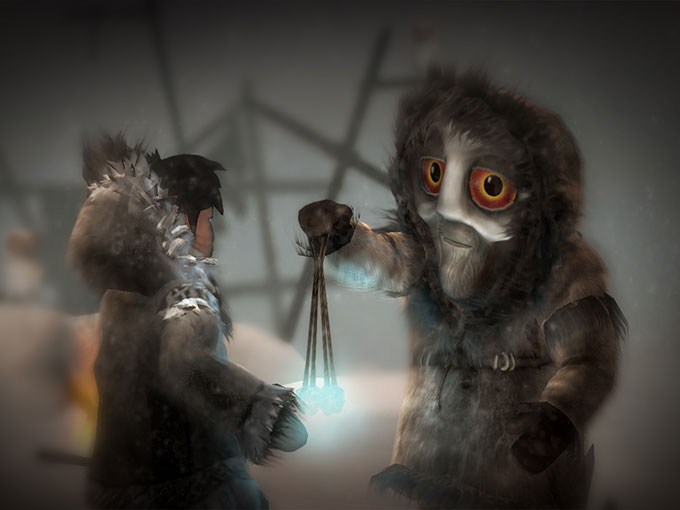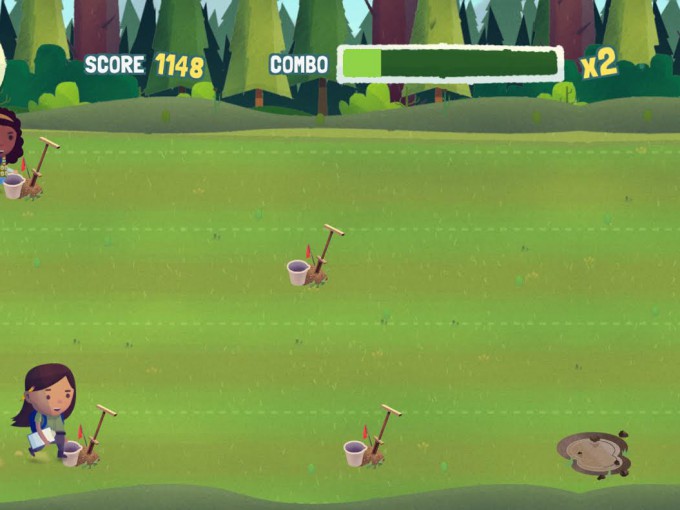It’s fitting that a new genre in storytelling was born from an Alaskan indigenous group that prides itself on just that. In striving to share the culture of the native Iñupiat people with global audiences—and to create new sources of revenue at home—the Cook Inlet Tribal Council of Alaska put its faith in the hands of Phoenix-based E-Line Media. The indie gaming publisher, co-founded by former Activision Studios SVP Alan Gershenfeld in 2010 to develop socially aware games, embarked on a two-year development process that involved more than 30 tribespeople and a number of trips north to Alaska. The efforts culminated in the November 2014 launch of Never Alone, a ground-breaking commercial video game built on the foundation of cultural storytelling—as well as an inclusive development process.
The tween-, teen- and young adult-skewing game, which is in the Iñupiat language and features 26 mini-documentary interviews with local indigenous residents, initially launched for PC, PlayStation 4 and Xbox One platforms, and iterations for Mac, WiiU and the Nvidia Shield tablet soon followed. Now, more than 2.5 million downloads later, Never Alone is set to roll out on Google Android and Apple iOS platforms this spring, and the property is looking to extend to television, books and, potentially, consumer products.
With design principles deeply rooted in real-world accuracy, Never Alone has helped pioneer a gaming genre meant to incite cultural awareness from its players. And a growing number of developers and marketers are turning their attention toward developing more games based on real-world concepts that are proving to have commercial viability as well as educational value—but not necessarily in the same explicit way that standard curriculum-based games do.
“Video games are an invitation with a contract…that’s the best definition that I’ve heard. And kids are naturally curious. By providing new perspectives, cultures and world views, it’s possible to have a deep impact,” says Gershenfeld. “There’s potential in the medium of gaming to do more than entertain and make money. That’s why I’ve been involved in the social impact business.”
“If kids see games as being outright educational, they are suspicious─it’s like a spinach sundae…”
– Michael Levine, Cooney Center
In Gershenfeld’s case, the business aspect is certainly in play. Short of divulging actual dollars earned, he says Never Alone has been profitable. In fact, the Cook Inlet Tribal Council has re-invested its windfall from the game’s revenue-sharing agreement in E-Line. “It is now our largest shareholder,” he says. “They converted their profits into equity in E-Line, so the Never Alone collaboration has actually spawned a real lifelong partnership between us.”
Gershenfeld is taking the Never Alone model to other parts of the globe, and he is actively talking to other cultural groups with the intention of releasing a full-scale gaming property that is developed in tandem with a local organization every few years. “We also want to support smaller developers that are from an indigenous culture. I’ve been contacted by some of the most remote parts of the world that have not seen many games,” says Gershenfeld, adding that E-Line has a team in place to measure the sustainability of potential new cultural projects. There are also games based on other real-world concepts in the pipeline at his company, such as a project currently in development on the human brain that’s aimed at tweens and teens.
“There is lots of stuff for young kids in terms of education, but there are fewer impact projects for tweens out there, and the bar should be higher because these players are able to make choices,” he says. “We want to make games that people are willing to pay for, so they have to be something beautifully crafted.”
This sort of authentic take on the world speaks directly to kids’ inherent interests and desires, according to Sesame Workshop’s Joan Ganz Cooney Center executive director Michael Levine. (He is also serving as an advisor on E-Line’s upcoming gaming concept on brain development.)
“There is a lot of research on kids these days being very interested in social change. And developers are leading the charge in creating this content. Even Minecraft is being modeled into ways that let kids build real-life communities outside of the game,” says Levine. He adds that the mental health benefits of interacting with socially aware content actually belie the long-held belief that gaming is simply a vacuous time dump. “While there are legitimate concerns about some children being addicted to especially violent games, the social impact movement may help counteract that. I’m seeing a more thoughtful and diverse industry emerging.”
Levine says ongoing research points to the fact that kids ages seven, eight and nine, in particular, have very important identity needs, and by seeing other cultures and real-world events, they are able to put their own personas into focus. “The most important thing a social impact game can do is promote a shared future, where social-emotional learning is involved.”
The Cooney Center’s understanding of social impact games dates back to 2009, when the nonprofit research organization issued a paper entitled Game Changer. The study was conducted around the same time that online game Free Rice broke ground as one of the first widespread social impact initiatives. The game, which sent grains of rice to the developing world thanks to kids’ online trivia answers, resulted in tens of millions of donations. A few years later, If You Can, the startup founded by former Electronic Arts founder Trip Hakwins, attracted US$6.5 million in funding in 2014 for its kid-friendly games based around promoting empathy and compassion.
More recently, UNICEF’s Kid Power initiative has shown that the trend of building social compassion through play is gaining ground. Kid Power is a physical and philanthropic campaign that harnesses wearable technology to donate relief packages to the developing world. By using a free app that syncs with a wearable Kid Power Band, more than 100,000 members have unlocked 315,000 food packets for malnourished kids around the globe through embarking on real-world missions that are based around new cultures. (Missions are available as in-app purchases.)
Initially launched in 2015 as a school-based initiative in the US, a mass-market retail experience is set to arrive by the 2016 holiday season.
“These games are being introduced to get kids on-board with a cause in a stealthy way that teaches them skills, attitudes and world knowledge that they need to have in a global economy,” says Levine. “If kids see games as being outright educational, they are suspicious—it’s like a spinach sundae that they can smell from a mile away.”
Take public parks, for example. They are rich with real-world learning opportunities for kids and take social education well beyond the classroom, which may explain why parks are the main focus of Games for Change’s social impact game that launched last month.
Save the Park is the brainchild of the US nonprofit and Pittsburgh-based developer Schell Games, in collaboration with American Express, which doled out US$250,000 to fund the initiative. It is a free iOS app designed to inspire kids and young adults to volunteer in national and local parks, and its release was timed with the centennial anniversary of the US National Park Service. The runner-style gaming app puts the player in the role of a park volunteer who has to keep bears away from coolers, pick up trash and greet visitors. It also features prompts on how tweens, teens and young adults can volunteer at a real-life park, which is its ultimate goal. (Very young kids can find out how to be junior rangers, too.)
“We want to support national parks, but the inspiration is to encourage young people to support nature as a whole. There is a level of stewardship and community service involved,” says Susanna Pollack, president of Games for Change, which helps create and distribute games that are meant to further humanitarian and educational efforts.
Pollack sees that social issues are on the minds of today’s young kids, and given that there are currently 1.4 billion gamers worldwide, she says a perfect storm is brewing in terms of reaching a compassionate cohort of players.
“The ultimate goal is to step into the shoes of someone around the globe. Save the Park isn’t categorized as educational, so it sits within the gaming section of App Store alongside Subway Surfer, but there are so many socially aware elements in play. There is no monetization program involved. It is truly just a social impact game.”
It also helps that American Express has pledged to donate US$1 per download (up to US$50,000) to the National Park Foundation. “Our only returns on investment are the positive effects the game imparts. But you can, of course, also have a successful economic model while making impactful games.”

























